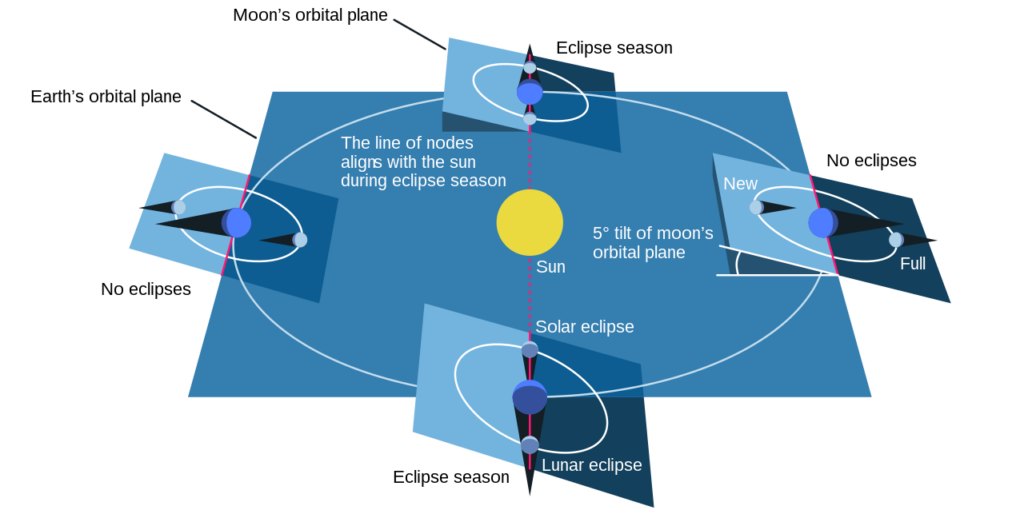A partial solar eclipse from 2021 coloured a stunning orange-red, photographed from Virginia in America. Featured Image Credits: Bill Ingalls, NASA
When does a solar eclipse occur?
For a solar eclipse to occur, the only requirement is that the Earth, the Moon, and the Sun are aligned in a straight line such that the Moon casts its shadow on the Earth. However, this is not an everyday phenomenon and is intrinsically related to their individual orbits (for more details, check out the article on planetary orbits here). Although the exact calculation of these orbits is highly nontrivial, one could, in principle, make some handwavy arguments to understand the dynamics.
Let us first consider the effects of gravity in the Sun-Earth system. The Sun, being the heavier, appears to be fixed in space. We may then shape our arguments from the viewpoint of the Sun. In response, the Earth assumes an elliptical orbit around the Sun which balances the inward pull and fixes its trajectory. A similar argument may be applied to the Moon orbiting the Earth. In a nutshell, the Earth revolves around the Sun and the Moon revolves around the Earth. The time periods to complete a single rotation, however, are one year for the former and around one month for the latter. At this point, one would expect that a solar eclipse would occur on every new moon, which, unfortunately, is not the case.

The dynamics is further complicated by the fact that the Moon’s orbit is tilted by about five degrees with respect to the Earth’s plane of revolution around the Sun (shown in the adjoining figure). The intersection of these planes, however, does not guarantee the occurrence of a solar eclipse. One also requires that the line of intersection aligns itself with the Sun-Earth line. The points in space where these conditions are met are called nodes and give rise to the so-called eclipse season – a period of roughly 32 days in which any new moon would result in an eclipse. In this way, we have already reduced the chances of an eclipse from once every month to at most twice a year.
Although these arguments serve as a good starting point for predicting solar eclipses, one must be aware of other factors in place that significantly affect the trajectories. A few of them include the fact that the Earth and the Moon are not perfectly rigid, spherical bodies, the effects of the Moon’s gravity on the Earth’s trajectory, and oceanic tides.
Glossary
| Term | Definition |
|---|---|
| Annular solar eclipse | A solar eclipse where the Moon doesn’t fully block out the Sun because the Moon appears smaller compared to the Sun. This is due to the Moon being near or at its furthest point away from Earth. |
| Lunar eclipse | Where the Earth lines up between the Sun and Moon, such that it blocks the Sun’s light from reaching the Moon. |
| Nodes | Points where the orbit of the Earth around the Sun and the orbit of the Moon around the Earth cross. When the Moon and Sun are near or at these points, a solar eclipse can occur. |
| Partial solar eclipse | A solar eclipse where the Moon doesn’t fully block out the Sun, due to the Moon not fully lining up with the Sun. |
| Phase (of the Moon) | A phase is the shape of the Moon visible at a specific time of the month. It takes about a month for the Moon to go through each of its eight Moon phases. |
| Saros cycle | A period of around 18 years, 11 days, and 8 hours. This slow repetitive rhythm can be used to predict when a solar or lunar eclipse can occur. |
| Solar eclipse | Where the Moon passes between the Earth and Sun and ends up blocking out some or all the Sun from view on Earth. |
| Total solar eclipse | A solar eclipse where the Moon completely blocks out the Sun’s light from view, from the Moon fully lining up with the Sun. |
Further reading
Bellstedt, S. (2023) Humans have been predicting eclipses for thousands of years, but it’s harder than you might think, Astronomy Magazine, [Accessed: 30 June 2023].
Seeds, M.A. (2007) ‘Chapter 3 – Section 4: Predicting Eclipses’, in Foundations of Astronomy. Belmont, CA: Thomson Brooks/Cole.
Stand-up Maths (2015) Solar Eclipse Maths and the Cosmic Coincidence of the Saros Cycle, YouTube. YouTube, [Accessed: 30 June 2023].